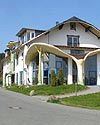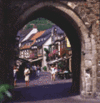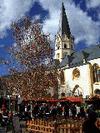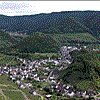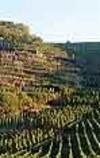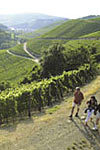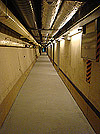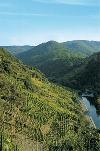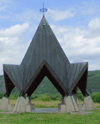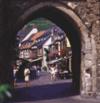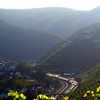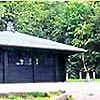The castle Landskron

The ruin, which can be seen from afar, is situated on the 272 metres high basalt cone at the lower Ahr Valley. The hill was called in the past Gimmiger Berg and is named now Landskron after the castle itself. The Landskron belongs to the district Lohrsdorf. Its peak is a nature reserve. The castle ruin is owned by Sebastian Graf von Kanitz at manor Cappenberg near Lünen. In Nassau at the Lahn is the ear's administration located. The area has been leased by the municipality Bad Neuenahr-Ahrweiler, who also manages it and takes care of it. The chapel at the hill's west side as well as the annually Pretzel Festival is being taken care of by the Heppinger Clubs.
History of the Castle Facility
The first picture is a drawing after old references 853First mention of the hill as "Mons Gimiche"1206The imperial castle was built by the Hohenstaufen Phillipp of Swabia in the fight of the throne against the Guelph Otto IV von Braunschweig and to safeguard the then important and most busy road, the 1km north running Krönungsstraße. It served at the same time as fortification for the then imperial territory around Sinzig, Remagen and Heimersheim. Gerhard von Sinzig is appointed as castellan. The Gerhards control the castle and their land until 1370.1208 King Philipp dies and the Guelph Otto IV takes over the castle.1214First castle siege by the Hohenstaufen Frederick II.Vor 1252Before 1252 the Earl of Neuenahr pawned the village of Gimmingen to Gerhard, Castellan of Landskron. Later Gimmingen appears with Kirchdaun as common possession of the earldom Neuenahr and the estate Landskron.1333Green near Lohrsdorf was bought in 1333 by Gerhard von Landskron. Latest since 1341 belonged Lohrsdorf to the imperial knightage Landskron. also part of the barony are the villages Nierendorf and Oedingen as well as, part-time, the barony Königsfeld with Dedenbach and Schalkenbach and Vinxt as well as Heckenbach in the imperial southernly woods along the lower Ahr and furthermore the barony Oberwinter with Birgel and Bandorf at times.1369The male posterity of the imperial knights of Landkron ended with the death of Gerhard IV in the year 1369. His son-in-law Friedrich von Tomburg and his wife Kunigunde inherited now the imperial direct barony.1371The imperial castle is being split for three families.1478 Added to the imperial knightage Landskron were Bodendorf, which belonged first to the imperial estate Sinzig and was since 1246 an enclave of Saffenburg.1616Spanish siege.1632/33 Siege byt Swedish, Spanish and Cologne troops.1652 The Landskron estate at the foot of the hill is burned down by Lothringen.16592/9 of the imperial castle comes through an area exchange to Jülich. A Jülish garrison comes to the castle.1677A large part of the castle was destroyed through a devastating fire.1682The castle is finally destroyed on order by the Duke of Jülich and the donjon is blown up. At the same time the Nine Year's War was taking place. The castle destruction was done so that the French could not establish themselves there and ravage the land; still this happened a few years later.

The Chapel
Just below the peak of the Landskron is another building, the chapel. The white walls of the west orientated chapel can be seen from afar. At this place there was probably a pagan cultural site in ancient times. The legend of the three virgins indicates this. A lord of the Landskrone constructed the chapel because of the wonderful rescue of his three daughters from robber barons. In 1212 issued King Otto V a writ of protection for the chapel also known as "Cluse". It is also called "Three Maidens". "Five maidens" and "Mairen Chapel".
The chapel was always subject of the parish Heimersheim. But today the Heppinger attend to the building and take care of its preservation. The castle itself had several own chapels inside the castle facility.
Castle Layout
The here seen reconstruction depicts buildings, which are after the layout, contemporary statement and sources can be explicitly allocated. Some buildings, named in the source are still missing. One has to imagine that the area of the lower castle was completely built-up in the 17th century.

 Deutsch
Deutsch Nederlands
Nederlands Dansk
Dansk Österreichisch
Österreichisch Po Polsku
Po Polsku






